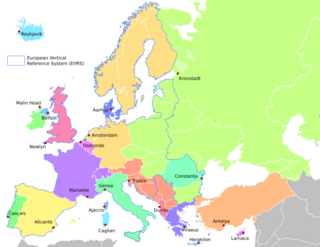Metres above the Adriatic
Metres above the Adriatic (Italian: Metri sopra l'Adriatico, German: Meter über Adria, Serbo-Croatian: Metara iznad Jadrana) is the vertical datum used in Austria, in the former Yugoslavian states of Slovenia, Croatia, Bosnia-Hercegovina, Serbia, Montenegro, North Macedonia, as well as in Albania to measure elevation, referring to the average water level of the Adriatic Sea at the Sartorio mole in the Port of Trieste.
Gauge

The gauging station in the Port of Trieste was established in the 1875 by the local observatory run by the military geographical institute of the Austro-Hungarian Army. The average water surface elevation at Molo Sartorio became the datum valid for the whole Austro-Hungarian monarchy. Whilst the former Yugoslavian states still use it, the Eastern Bloc successor states of Austria-Hungary like Hungary and Czechoslovakia after World War II switched to the Kronstadt Gauge of the Baltic Sea, which is 0.6747 m (2.214 ft) higher.
Whilst for Austria the 1875 gauge is used as the datum, the states of former Yugoslavia use the 1900 gauge (Nadmorska visina, m/nv). In Albania (normal-orthometric height) they also refer to heights as 'metres above the Adriatic', but use a specific tide gauge in the port of Durrës.
Abbreviation
The individual countries using this datum abbreviate it in different ways depending on their local language, as follows:
- Austria: m ü. Adria, m.ü.A. or müA, colloquially known as Seehöhe or Adriahöhe
- Hungary: mAf from méter Adria felett
- Former Yugoslavian states: m. i. J. from Metara iznad Jadrana
'Metres above the Adriatic' may be abbreviated in English to m AA
Height differences between Austria and neighbouring countries
In Austria orthometric height is used, while its neighbours use other height systems, which leads to differences. On the state borders these differences are:
- Germany : +25 to +34 cm, normal height according to the Normalhöhennull levelling system based on the Amsterdam Ordnance Datum
- Italy: −0.5 to −3.2 cm, orthometric height referring to Genoa Tide Gauge
- Switzerland and Liechtenstein: −1.6 to −7.5 cm, orthometric height – 'Metres above the Sea' (Meter über Meer) based on the elevation of the Pierres du Niton in Lake Geneva at 373.6 m (1,226 ft) above average Marseille Tide Gauge
- Slovakia: +57 cm, normal height based on Kronstadt Tide Gauge
- Slovenia: −8 to −12 cm, orthometric height – metres above the sea referring to Koper Tide Gauge[1]
- Czech Republic: +46 to +56.3 cm, normal height based on Kronstadt Tide Gauge, and
- Hungary: +49.6 to +60.6 cm, normal height – 'Height above Sea Level' (Hungarian: Tengerszint feletti magasság) based on the elevation of the Nadap benchmark at 173.1638 m (568.123 ft) above Kronstadt Tide Gauge.
(Differences: HAustria − Hneighbouring states)[2]
See also
- Metre
- Normalhöhennull (NHN) (equivalent in Germany)
- Metres above the Sea (Switzerland)
References
- ↑ "S pomočjo mareografske postaje v Kopru do novega geodetskega izhodišča za Slovenijo" (in Slovenian). Slovenian Environment Agency. 23 November 2016. http://www.arso.gov.si/o%20agenciji/novice/.
- ↑ Map with height differences by the Austrian federal office for metrology and surveying, Bundesamt für Eich- und Vermessungswesen
External links
- (in Italian) Trieste Institute of Marine Sciences
- (in German) Austrian Federal Office of Metrology and Surveying
[ ⚑ ] 45°38′49″N 13°45′36″E / 45.646867°N 13.759867°E
 |



